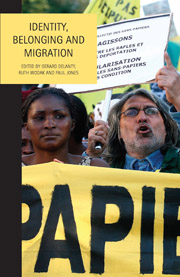Book contents
- Frontmatter
- Contents
- Acknowledgements
- List of Figures
- Notes on Contributors
- Introduction: Migration, Discrimination and Belonging in Europe
- I Theoretical Perspectives on Belonging
- 1 Belonging and European Identity
- 2 Identity, Belonging and Migration: Beyond Constructing ‘Others’
- 3 ‘Us’ and ‘Them’: Inclusion and Exclusion – Discrimination via Discourse
- 4 Dilemmas of Secularism: Europe, Religion and the Problem of Pluralism
- II Institutional Forms of Discrimination
- III Cases of Belonging and Exclusion
- Conclusion: Discrimination as a Modern European Legacy
- Index
3 - ‘Us’ and ‘Them’: Inclusion and Exclusion – Discrimination via Discourse
from I - Theoretical Perspectives on Belonging
- Frontmatter
- Contents
- Acknowledgements
- List of Figures
- Notes on Contributors
- Introduction: Migration, Discrimination and Belonging in Europe
- I Theoretical Perspectives on Belonging
- 1 Belonging and European Identity
- 2 Identity, Belonging and Migration: Beyond Constructing ‘Others’
- 3 ‘Us’ and ‘Them’: Inclusion and Exclusion – Discrimination via Discourse
- 4 Dilemmas of Secularism: Europe, Religion and the Problem of Pluralism
- II Institutional Forms of Discrimination
- III Cases of Belonging and Exclusion
- Conclusion: Discrimination as a Modern European Legacy
- Index
Summary
Introducing Discursive Dimensions of ‘Inclusion and Exclusion’
Racial discrimination includes all acts – verbal, nonverbal, and paraverbal – with intended or unintended negative or unfavourable consequences for racially or ethnically dominated groups. It is important to see that intentionality is not a necessary component of racism.
Essed 1991: 45Philomena Essed (1991) has captured many aspects of contemporary discrimination in this quotation: discriminatory acts may manifest themselves on all levels of language; exclusion is linked to power; marginalized groups tend to be discriminated against; and discriminatory acts may be intended or non-intended. Discrimination may be legally legitimized, it may be structural or it may occur in passing. In her seminal book Everyday Racism, Essed focuses on ‘everyday racism’ in the Netherlands and in California (1991), although her definition in its general and broad meaning covers many racist and discriminatory phenomena, many dimensions of ‘inclusion’ and ‘exclusion’.
Before elaborating on the concepts of inclusion and exclusion – and on their application to discriminatory practices in the European Union and elsewhere – it is necessary to state a caveat: one way of looking at discourses of difference/discrimination is to examine the ways in which minorities or migrants actually experience racial discrimination in European societies today. However, such analysis cannot lead us to a causal explanation of racial inequality, although it will provide relevant knowledge about the many facets of racial discrimination from the perspective of the marginalized and vulnerable – that is to say, an ‘insider’ perspective (see Krzyżanowski and Wodak 2007).
- Type
- Chapter
- Information
- Identity, Belonging and Migration , pp. 54 - 77Publisher: Liverpool University PressPrint publication year: 2011
- 23
- Cited by



